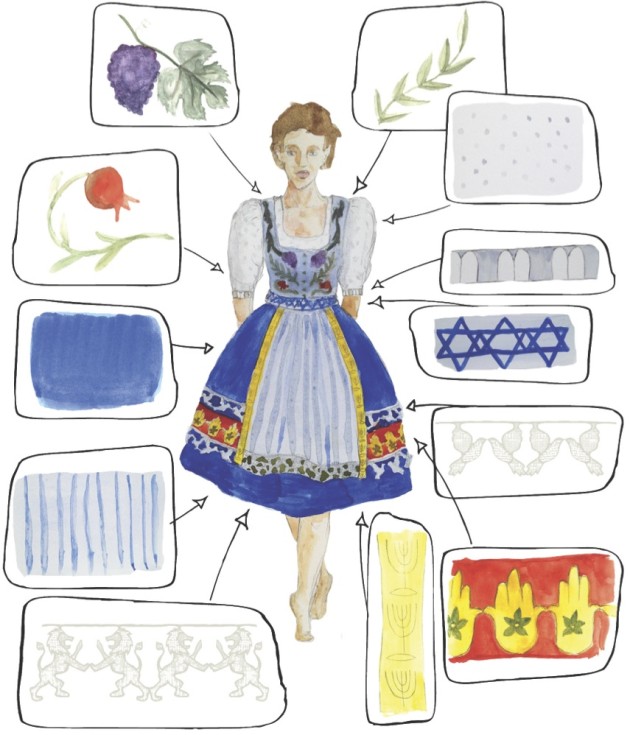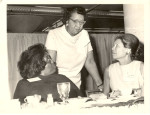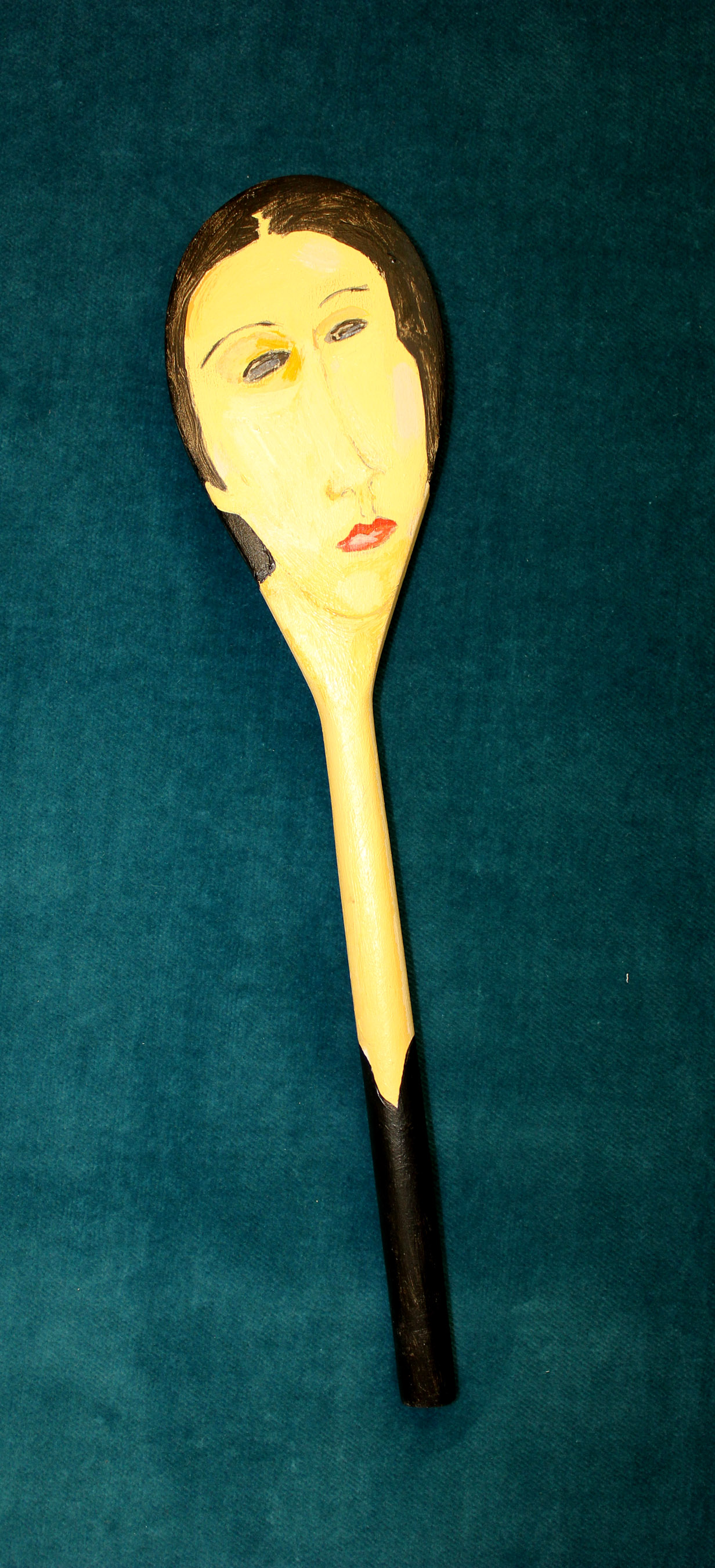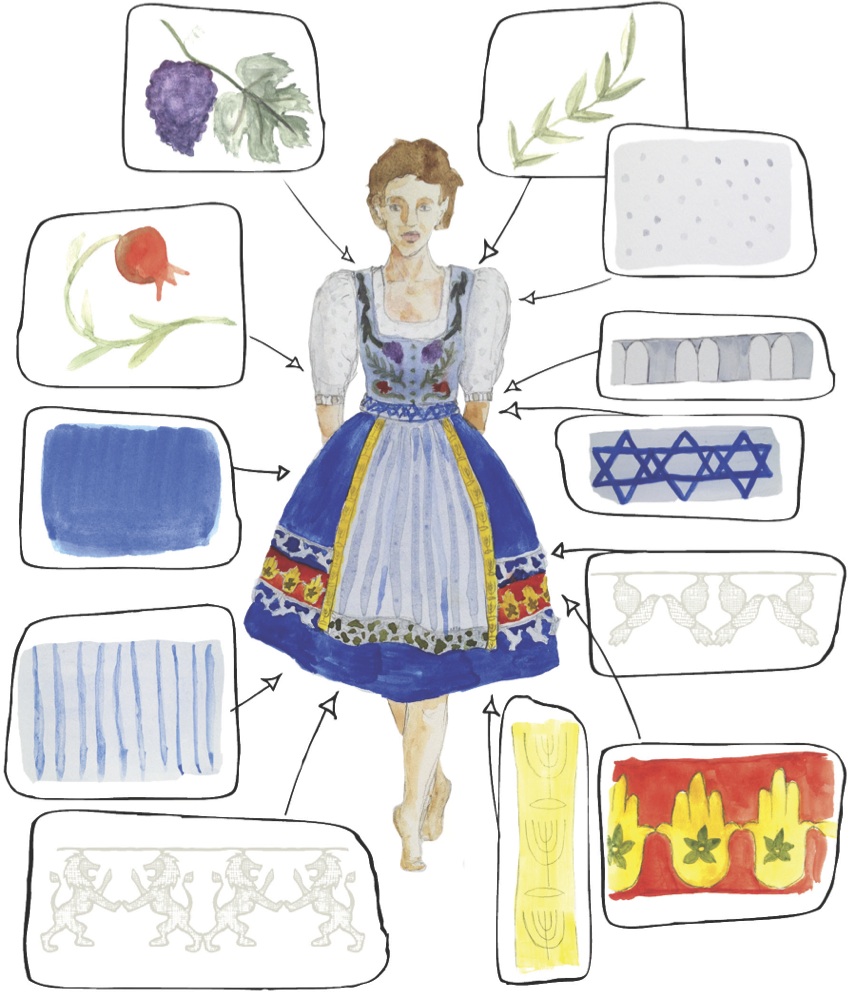by Karen Engel
Should a Jewish Girl Wear a Dirndl? (And Other Questions About Jews And Tracht)

Illustration by Shifra Whiteman
It was Erev Rosh Hashana and my 19-year-old daughter, Janina, was joining us at synagogue after spending the day at a city-wide festival in the province of southern Austria where we live. Every September, folk music groups, artisans, folk dancers, and a lot of tourists throng the medieval streets of Graz to celebrate Styrian folk culture, which importantly includes dirndls — a traditional dress with an apron, bodice and relatively low-cut blouse. Not only are dirndls not typical feminist attire, but Jews, historically speaking, have a troubled relationship with them, as well as with their male counterpart, lederhosen.
So when Janina breezed into shul that warm September evening dressed like an Austrian peasant, a visitor turned to her and asked incredulously, “Are you Jewish?”
Janina, who grew up in Graz and has attended services her whole life here, was deeply offended.
“Of course I’m Jewish,” she answered.
For many jews, dirndls and lederhosen are almost on the order of swastikas, associated as they are with right-wing political groups and with the Nazi glorification of German volk culture. When the Nazis marched into Austria in 1938, one of the first things they did was ban Jews from wearing them.
Tracht (the German term for traditional folkloric dress) was popular among Jews and other members of the rising upper and middle classes before the Holocaust, especially the well-to-do who packed up their belongings each summer and moved to Alpine resorts like Bad Ischl and Bad Aussee. Dressing up in Tracht was campy and fun, and it was also an appropriation of Austrian insider-ness. When Hitler forbade Jews to wear dirndls and lederhosen, he understood the semiotics.
In the last few years, Tracht has staged a fashionable comeback in both Austria and Germany, and it’s suddenly not uncommon to see teens and twenty-somethings wearing dirndls and lederhosen to weddings, parties and even to the office. Variations abound, from traditional fabrics and designs specific to certain regions or towns (like the Black Forest and Bad Aussee) to “designer Tracht” by such rising stars as Lena Hoschek who mixes old motifs with new styles and fabrics. Gloria Cudjo of Hamburg has started a unique line of Tracht that uses African materials — a culture-clash expression of her Ghana-German identity. And then, of course, there’s always Tracht kitsch for tourists, immutably gaudy and inexpensive.
But a Jewish girl wearing a dirndl?
Well, the history of tracht is bound up with Jews in more ways than one. Although dirndls and lederhosen originated some 400 years ago as the work clothes of Alpine peasants — with a finer version for Sundays and holidays designating a person’s social, marital and economic status — they became more popular in the 19th century, largely as a romantic response to the modern industrial age.
Tracht was worn mainly in the countryside. In 1900, though, two Jewish brothers, Julius and Moritz Wallach, opened a clothing store in the Bavarian city of Munich and had the clever and successful idea of marketing dirndls and lederhosen as a kind of urban “rural chic.” In 1939, the Wallachs’ store was “Aryanized.” And today, when one thinks of all the lederhosen and dirndls worn by beer-guzzling Germans (and tourists) at Munich’s huge Oktoberfest, it’s odd to think about two Jews spearheading this fashion trend.
Before the Holocaust, Jews not only wore Tracht, they were also germinal ethnographers of Alpine and folkloric culture. In the 1920s, Eugenie Goldstern’s research on Alpine cultures of the Habsburg monarchy was groundbreaking in its focus on how these societies adapted to change. This was in contrast to other scholars’ idealized presentation of Alpine life as untainted by, and immune to, change. Goldstern’s collections of folk art and artifacts became important mainstays of both the Vienna and Bern museums of folklore.
She fought against the nationalist and racist ideologies that were ruggedly in vogue in the field of ethnography in her time, but she failed to recognize how dangerous they had really become. In June of 1942, Goldstern was deported from Vienna to Lublin, where she died in the Sobibor extermination camp.
Much of what we know today about Austrian folk music (and Alpine culture as well) is thanks to another Austrian Jew, Konrad Mautner (1880 –1924), the son of a Viennese textile merchant who loved the country life. He spoke dialect, wore lederhosen, and relished hunting, fishing, singing, dancing and smoking with the locals of the small village of Gössl in the picturesque Salzkammergut region of Austria. Mautner’s collections of Austrian folk songs and Tracht are fundamental to today’s understanding of Austrian folk culture.
Since 2006, the Konrad Mautner Prize has been awarded every two years to a person who promotes the wearing of Tracht. In 2008, the award went to the Austrian actor and writer Miguel Herz-Kestrenek, who happens also to be a Jew; he comes from a prominent, assimilated Austrian-Jewish family.
“My father was forbidden to wear [lederhosen] and so was my grandfather. I wear lederhosen precisely because Jews were once forbidden to,” he said in his acceptance speech. “Tracht is not the expression of, nor a relic of, the era of blood, soil and race, but rather a protest against it. It is not a uniform, but its opposite: an expression of extreme individualism, not only from valley to valley, but from village to village.”
Herz-Kestrenek received the prize exactly 70 years after the Anschluss of Austria to Nazi Germany, a fact that was noted prominently in his speech.
Herz-Kestrenek’s logic also informs the attitudes of Claudia Saltiel, a friend of mine and a member of Graz’s Jewish community. Claudia hates uniforms, whether dictated by the military or fashion. She not only grew up wearing dirndls, but her family includes four generations of Jewish dirndl-wearing women. She says that her grandmother, who was originally from Czernowitz (in today’s Romania), wore dirndls to “fit in” with Bad Ischl society. Her mother, as a very young girl in Salzburg, survived the Holocaust in hiding — and after that always wore dirndls as was common in the Salzburg region, where she continued to live after the war. Claudia’s daughter, Rivka, wears dirndls from time to time because, she says simply, “I like them.”
It’s one thing, though, when your friends wear dirndls, and another when your own daughter starts wearing them. As a Jewish-American feminist who moved to Austria more than 20 years ago as a radio reporter, I have mixed feelings about Tracht.
I have to admit that dirndls have a very flattering cut, and at different times during their childhoods, I dressed both my girls in them for special occasions. The girls always looked adorable; never overdressed or sexy. Unlike my daughters, though, I am not even half-Austrian, so dirndls aren’t part of my heritage.
My daughter Janina, who graduated from a secondary school that specializes in fashion design, tells me that she likes dirndls not only as an expression of her mixed cultural heritage, but also as a feminist.
“The fashion
industry is all about women being skinny, and the dirndl is a statement in defiance of that,” she says. “It doesn’t matter how fat or how skinny you are; women with very curvy bodies look great in dirndls.”
She also has feelings about wearing that dirndl to synagogue.
“Jews especially should wear them because there were laws prohibiting us from doing so. I want to signal that I’m Jewish, I’m Austrian, and I’m proud to be both Jewish and Austrian. We live in the 21st century! This should not even be a question.”
Nonetheless, I doubted I would ever wear a dirndl myself — except then I realized that I already had. A few years ago, I came across the only image of me as a child taken by a professional photographer: in a dirndl. I don’t know who chose that outfit — my parents were Polish- and American-born, my father losing many family members in the Holocaust — and today I can’t ask them anymore.
But they must’ve seen the dirndl as simply a dress. Is it time for me to try to do that, too?
Karen Engel has reported for NPR, the Austrian Broadcasting Corporation and Deutsche Welle, and co-founded a Jewish cultural center in Graz. Her daughter Janina was the first girl in Graz to chant from the Torah; her daughter Milena the first to chant her Haftorah as well.
The Politics of Paradox
The articles in this special section:
Wednesdays in Mississippi
by Holly Cowan Shulman
Polly Cowan worked to bring interracial teams of glove- and hat-wearing middle-class Northern women to Mississippi every Wednesday during Freedom Summer. Polly’s daughter figures out what drove her mother’s work.

BLT Judaism
by Rachel Kadish
Bacon? One woman creates her own Jewish tradition out of the most untraditional food of all.

Should a Jewish Girl Wear a Dirndl? (And Other Questions About Jews And Tracht)
by Karen Engel
In Germany and Austria, traditional German peasant dresses, like the dirndl — once forbidden for Jews to wear — have made a comeback. Is it okay when even the author’s daughters are wearing them? And here’s a rundown of the restrictions on Jewish women’s clothing over the centuries, in case you thought the yellow star was a first.
 Please wait...
Please wait...